Online ads
Contents
Online ads#
In this problem set we analyse the relationship between online ads and purchase behavior. In particular, we want to classify which online users are likely to purchase a certain product after being exposed to an online ad.
Data preparation#
import pandas as pd
df = pd.read_csv("https://raw.githubusercontent.com/kirenz/datasets/master/purchase.csv")
df
| Unnamed: 0 | User ID | Gender | Age | EstimatedSalary | Purchased | |
|---|---|---|---|---|---|---|
| 0 | 1 | 15624510 | Male | 19 | 19000 | 0 |
| 1 | 2 | 15810944 | Male | 35 | 20000 | 0 |
| 2 | 3 | 15668575 | Female | 26 | 43000 | 0 |
| 3 | 4 | 15603246 | Female | 27 | 57000 | 0 |
| 4 | 5 | 15804002 | Male | 19 | 76000 | 0 |
| ... | ... | ... | ... | ... | ... | ... |
| 395 | 396 | 15691863 | Female | 46 | 41000 | 1 |
| 396 | 397 | 15706071 | Male | 51 | 23000 | 1 |
| 397 | 398 | 15654296 | Female | 50 | 20000 | 1 |
| 398 | 399 | 15755018 | Male | 36 | 33000 | 0 |
| 399 | 400 | 15594041 | Female | 49 | 36000 | 1 |
400 rows × 6 columns
df.info()
<class 'pandas.core.frame.DataFrame'>
RangeIndex: 400 entries, 0 to 399
Data columns (total 6 columns):
# Column Non-Null Count Dtype
--- ------ -------------- -----
0 Unnamed: 0 400 non-null int64
1 User ID 400 non-null int64
2 Gender 400 non-null object
3 Age 400 non-null int64
4 EstimatedSalary 400 non-null int64
5 Purchased 400 non-null int64
dtypes: int64(5), object(1)
memory usage: 18.9+ KB
# make dummy variable
df['male'] = pd.get_dummies(df['Gender'], drop_first = True)
# drop irrelevant columns
df.drop(columns= ['Unnamed: 0', 'User ID', 'Gender'], inplace = True)
# inspect outcome variable
df['Purchased'].value_counts()
0 257
1 143
Name: Purchased, dtype: int64
# prepara data for scikit learn
X = df.drop(columns=['Purchased'])
y = df.Purchased
# make data split
from sklearn.model_selection import train_test_split
X_train, X_test, y_train, y_test = train_test_split(X, y, test_size=0.3, random_state = 123)
# create new training dataset for data exploration
train_dataset = pd.DataFrame(X_train).copy()
train_dataset['Purchased'] = pd.DataFrame(y_train)
train_dataset
| Age | EstimatedSalary | male | Purchased | |
|---|---|---|---|---|
| 177 | 25 | 22000 | 1 | 0 |
| 105 | 21 | 72000 | 1 | 0 |
| 5 | 27 | 58000 | 1 | 0 |
| 288 | 41 | 79000 | 1 | 0 |
| 279 | 50 | 36000 | 0 | 1 |
| ... | ... | ... | ... | ... |
| 230 | 35 | 147000 | 0 | 1 |
| 98 | 35 | 73000 | 1 | 0 |
| 322 | 41 | 52000 | 1 | 0 |
| 382 | 44 | 139000 | 0 | 1 |
| 365 | 59 | 29000 | 0 | 1 |
280 rows × 4 columns
Exploratory data analysis (EDA)#
train_dataset.groupby(by=['Purchased']).describe().T
| Purchased | 0 | 1 | |
|---|---|---|---|
| Age | count | 180.000000 | 100.000000 |
| mean | 32.672222 | 46.090000 | |
| std | 8.176018 | 8.589511 | |
| min | 18.000000 | 27.000000 | |
| 25% | 26.000000 | 39.000000 | |
| 50% | 33.500000 | 47.000000 | |
| 75% | 39.000000 | 53.000000 | |
| max | 59.000000 | 60.000000 | |
| EstimatedSalary | count | 180.000000 | 100.000000 |
| mean | 59788.888889 | 85460.000000 | |
| std | 22884.697356 | 41858.207020 | |
| min | 15000.000000 | 20000.000000 | |
| 25% | 46500.000000 | 38750.000000 | |
| 50% | 60000.000000 | 92000.000000 | |
| 75% | 76250.000000 | 122000.000000 | |
| max | 134000.000000 | 150000.000000 | |
| male | count | 180.000000 | 100.000000 |
| mean | 0.527778 | 0.420000 | |
| std | 0.500620 | 0.496045 | |
| min | 0.000000 | 0.000000 | |
| 25% | 0.000000 | 0.000000 | |
| 50% | 1.000000 | 0.000000 | |
| 75% | 1.000000 | 1.000000 | |
| max | 1.000000 | 1.000000 |
Purchasers are (on average) _______ and earn a __________ estimated salary than non-purchasers.
Visualization of differences:
import seaborn as sns
sns.pairplot(hue='Purchased', kind="reg", diag_kind="kde", data=train_dataset);
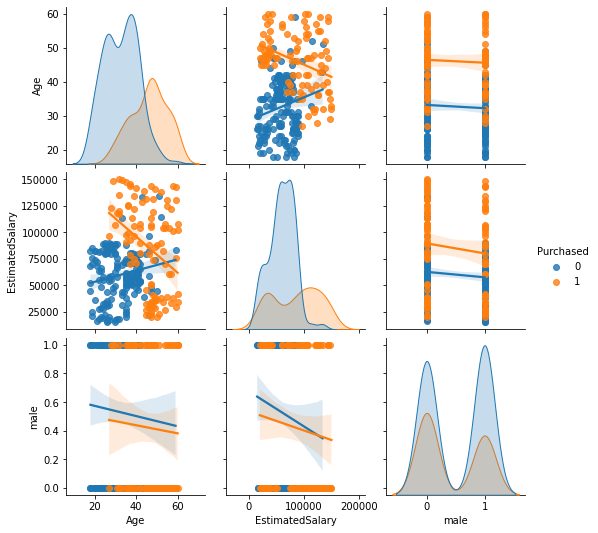
Inspect (linear) relationships between variables with correlation (pearson’s correlation coefficient)
df.corr().round(2)
| Age | EstimatedSalary | Purchased | male | |
|---|---|---|---|---|
| Age | 1.00 | 0.16 | 0.62 | -0.07 |
| EstimatedSalary | 0.16 | 1.00 | 0.36 | -0.06 |
| Purchased | 0.62 | 0.36 | 1.00 | -0.04 |
| male | -0.07 | -0.06 | -0.04 | 1.00 |
sns.kdeplot(hue="Purchased", x='Age', data=train_dataset);
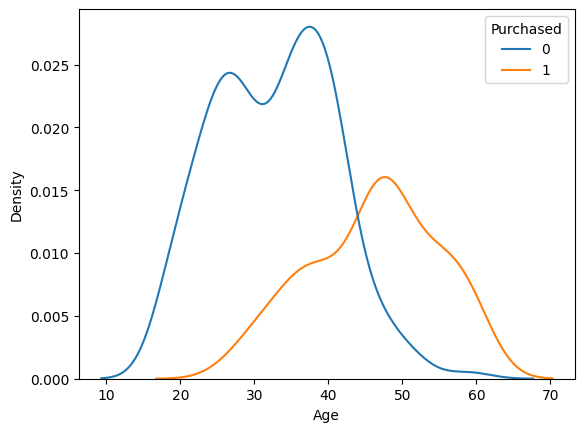
Purchasers seem to be _________ than non-purchaser.
sns.boxplot(x="male", y="Age", hue="Purchased", data=train_dataset);
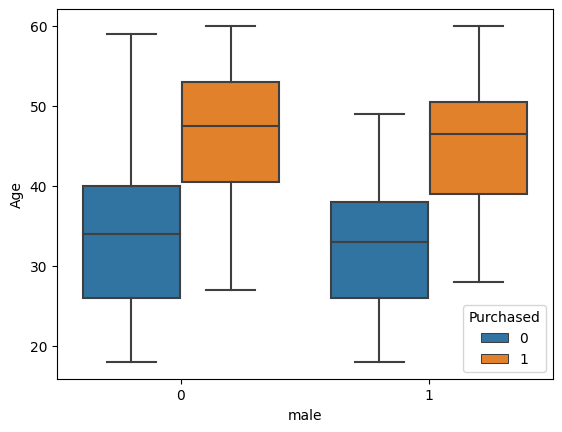
There are __________ differences regarding gender.
sns.kdeplot(hue="Purchased", x='EstimatedSalary', data=train_dataset);
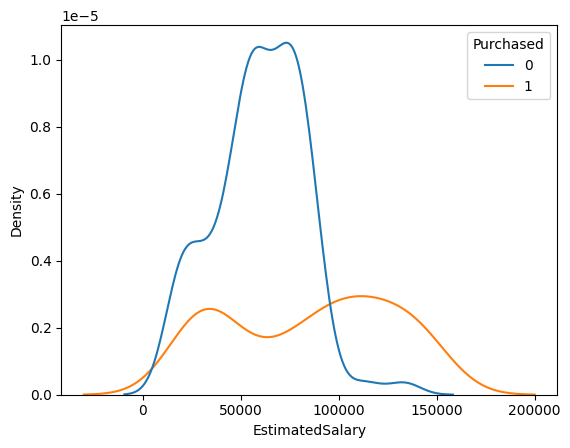
Purchaser earn a ______________ estimated salary.
sns.boxplot(x="male", y="EstimatedSalary", hue="Purchased", data=train_dataset);
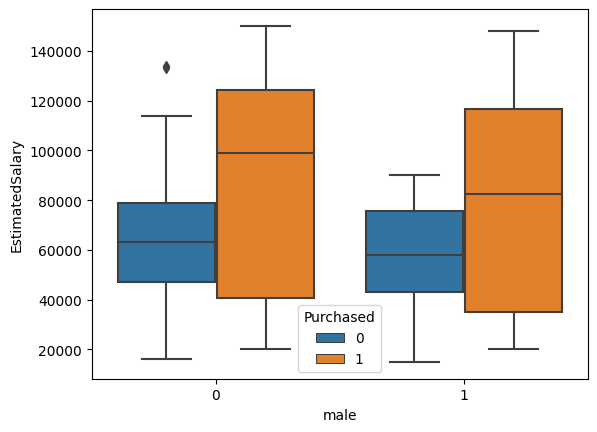
Insight: there are ___________ differences between males and females (regarding purchase behavior, age and estimated salary)
Model#
Next, we will fit a logistic regression model. In particular, we use a model that has built-in cross-validation capabilities to automatically select the best hyper-parameter for our model.
We only use our most promising predictor variables Age and EstimatedSalary for our model.
# only use meaningful predictors
features_model = ['Age', 'EstimatedSalary']
X_train = X_train[features_model]
X_test = X_test[features_model]
from sklearn.linear_model import LogisticRegressionCV
# model
clf = LogisticRegressionCV()
# fit model to data
clf.fit(X_train, y_train)
# prediction
y_pred = clf.predict(X_test)
Classification metrics#
# Return the mean accuracy on the given test data and labels:
clf.score(X_test, y_test)
0.825
from sklearn.metrics import ConfusionMatrixDisplay
ConfusionMatrixDisplay.from_estimator(clf, X_test, y_test);
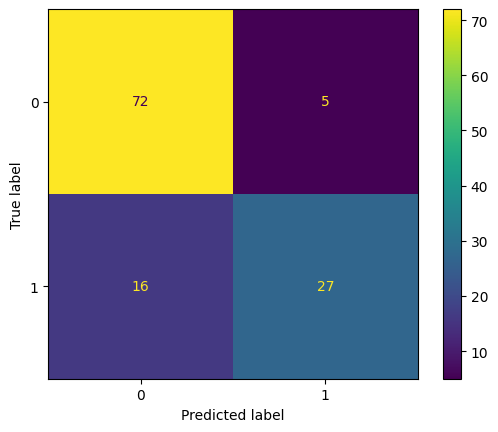
from sklearn.metrics import classification_report
print(classification_report(y_test, y_pred, target_names=['Not purchased', 'Purchased']))
precision recall f1-score support
Not purchased 0.82 0.94 0.87 77
Purchased 0.84 0.63 0.72 43
accuracy 0.82 120
macro avg 0.83 0.78 0.80 120
weighted avg 0.83 0.82 0.82 120
macro: Calculate metrics for each label, and find their unweighted mean. This does not take label imbalance into account.
weighted: Calculate metrics for each label, and find their average weighted by support (the number of true instances for each label). This alters ‘macro’ to account for label imbalance.
Note that recall is also sometimes called sensitivity or true positive rate.
High scores for both precision and recall show that the classifier is returning accurate results (high precision), as well as returning a majority of all positive results (high recall).
The importance of precision vs recall depends on the use case at hand (and the costs associated with missclassification).
A system with high recall but low precision returns many results, but most of its predicted labels are incorrect when compared to the training labels.
A system with high precision but low recall is just the opposite, returning very few results, but most of its predicted labels are correct when compared to the training labels.
An ideal system with high precision and high recall will return many results, with most results labeled correctly.
The unweighted recall of our model is _____
The unweighted precision of our model is _____
ROC Curve#
from sklearn.metrics import RocCurveDisplay
RocCurveDisplay.from_estimator(clf, X_test, y_test)
<sklearn.metrics._plot.roc_curve.RocCurveDisplay at 0x7f2e602a5e50>
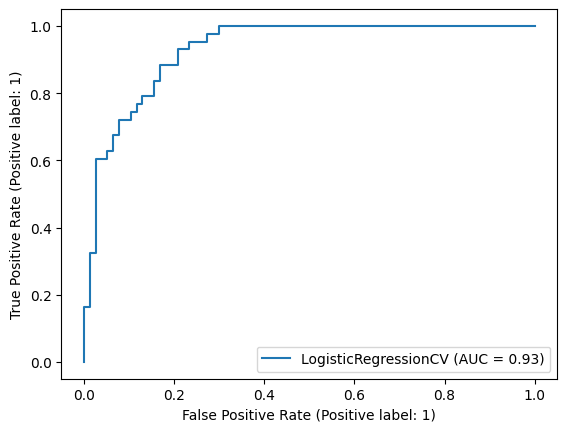
AUC Score#
from sklearn.metrics import roc_auc_score
y_score = clf.predict_proba(X_test)[:, 1]
roc_auc_score(y_test, y_score)
0.9311386288130474

